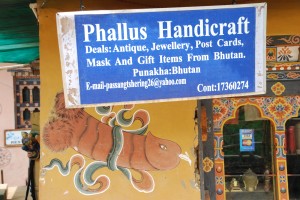Fertility symbols and temples
We woke from our floor mattress bedding to the early morning sounds of chickens and cows in our remote farmstay in central Bhutan. It was foggy and drizzly outside, no wonder from this mountain perch of the Himalaya foothills, but we consumed a functional breakfast that looked remarkably like last night’s dinner warmed up and headed back down the white-knuckle switchback track to the valley below. Travelling on normal roads back home again will seem so boring compared to the thrills and views of high-mountain traversing in Bhutan.
We hugged the road down the valley to the town of Wangdue, notable because a few years ago the government decided to move it to a sterile group of buildings in an uncharacteristically square and flavourless set of town blocks. Up the new valley we bumped along to the town of Punakha, which we found out the government also moved because the old location was too run down and close to their beautiful dzong. This country has quite a few issues to face and moving entire towns is clearly one of them.
Julie and I have fallen in love with dzongs, you can’t help but be impressed by their imposing size and ancient architecture, their unique features and deep cultural significance. They are monster structures you can’t stop photographing. But what we really like about them is that they are still are living breathing centres of religion and administration. The King currently works in the dzong in Thimpu and all the rest of them act as district administration centres as well as the major monastery for monks in the region.
The Punakha dzong has a commanding view sitting over the confluence of two major rivers. Its first structure dates from the 14th century but the current fortress is from 1637. Today it houses the administration offices for the Punakha District as well as the learning and living centre for 450 monks. It also was where the wedding of the current king began in 2008 (the wedding ceremony travelled to most major districts) and it acted as the national capital from 1900 to 1955. This dzong has serious cred.
The fortress walls were surrounded by huge jacaranda trees in beautiful full purple bloom, swarming with crimson-coloured monks and featuring the biggest and best temple inside its walls. We’ve got more dzongs to go on this trip but Punakha is our strong favourite so far.
After dragging ourselves away from the Punakha Dzong we nailed a dozen more switchbacks before arriving at a place called Sopsokha where we started a 30 minute walk across the rice paddies and through a small village to a 15th century temple on the top of a hill. This temple, called Chimi Lhakhang, was built in honour of a legendary saint who seemed to have a novel approach to spreading the gospel, including by sexually subduing rivals, their wives, nearby animals, just about anything that moved.
The temple, which is now known for its unique powers of fertility, is where childless couples come to pray for a baby. Graphic phallic symbols adorn nearby farmhouses, souvenir shops and restaurants. We were told this is a symbol of good luck and happiness…who can argue with that?
We continued back up and over Dochu La Pass at 3080 metres, the sixth time this week we drove over a 3,000 metre pass, foggy and rainy as it was. Down the winding road, bypassing the capital Thimphu and up the Paro Valley, past the airport, such as it is, to the town of Paro. Paro’s dzong stands sentinel over the town and again we couldn’t help but be reminded and impressed by Bhutan’s ancient history. After a bit of a wander around this one street town we headed about 10 km further up the valley to our hotel, only a few years old and sporting views of the valley and the dzong from our balcony (our third balcony on this trip to feature dzongs). Have you noticed how I like to say the word dzong?













